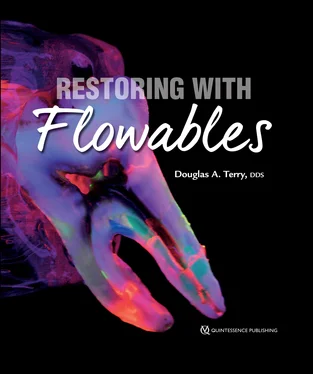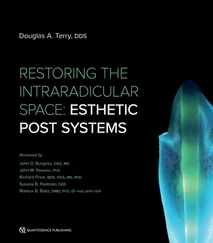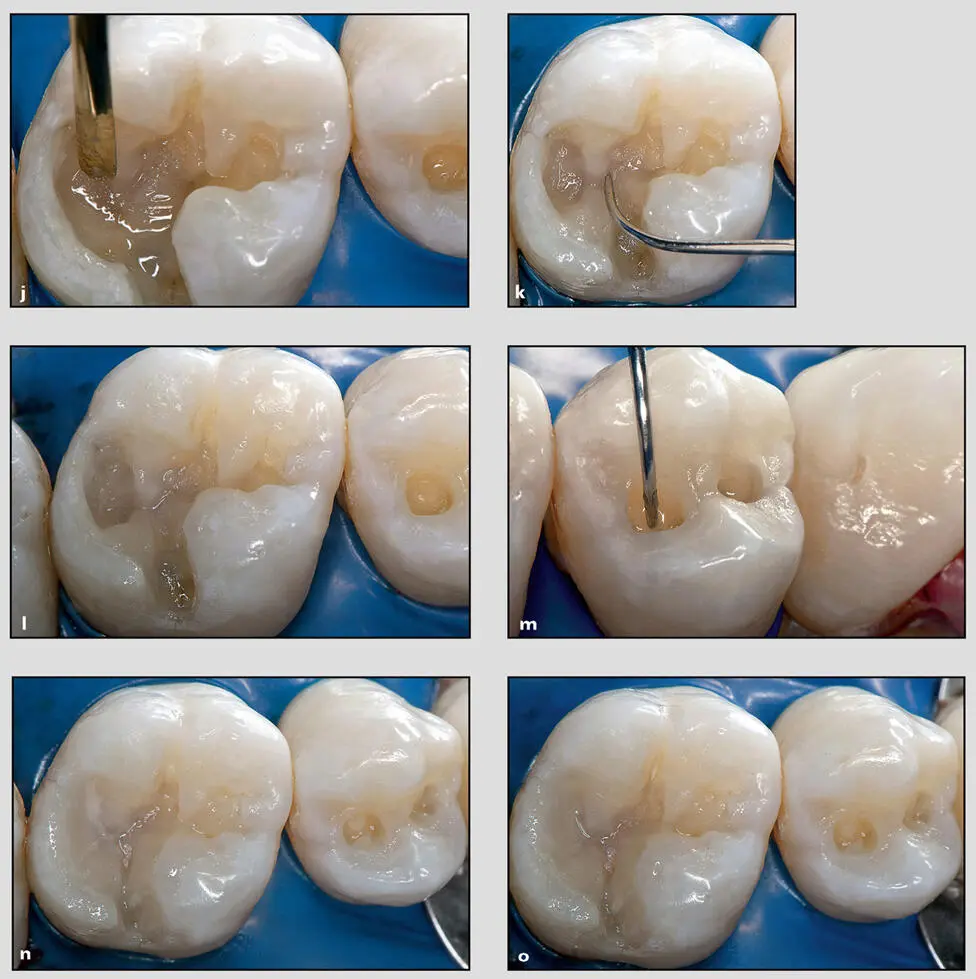
Fig 1-3 (cont) (j to l) An opacious A2-shaded hybrid resin composite (Kalore) was applied to the first molar in increments using an oblique layering build-up technique. Successive increments of hybrid composite were applied and light cured for 40 seconds each. (m and n) An opacious A2-shaded flowable resin composite (G-aenial Universal Flo) was applied to the second premolar in increments using an oblique layering build-up technique. Successive increments of flowable composite were applied and light cured for 20 seconds each. (o) Anatomical stratification buildup using two different resin composite systems.
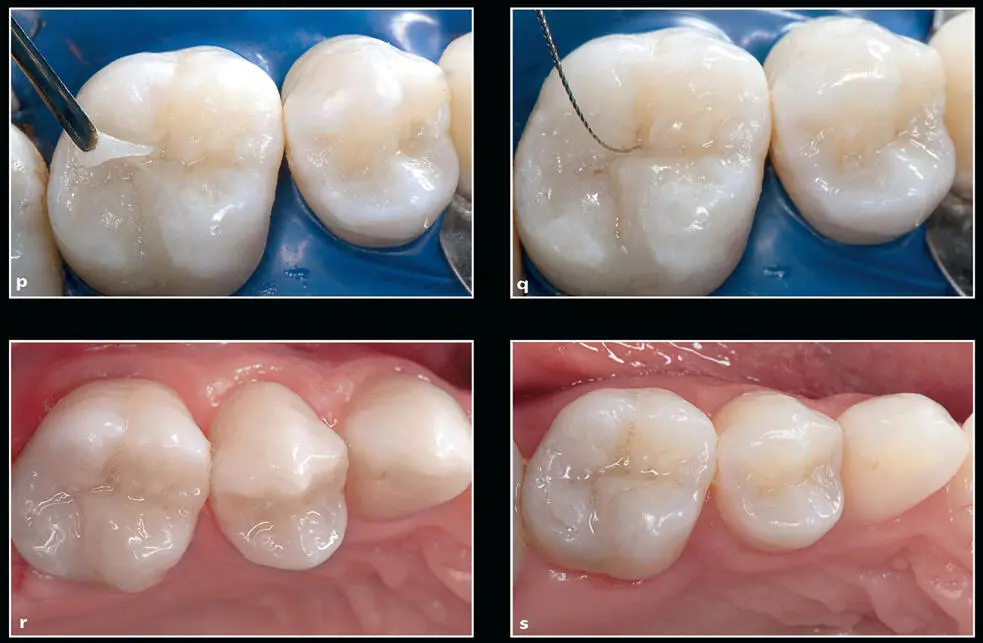
Fig 1-3 (cont) (p and q) The final occlusal layer, a translucent A1-shaded hybrid resin composite (Kalore), was applied to the first molar with a long-bladed interproximal instrument and invaginated with an endodontic file while the material was still soft. This same procedure was performed on the second premolar using a translucent A1-shaded flowable resin composite (G-aenial Universal Flo). A diluted ochre tint (Kolor + Plus, Kerr) was applied into specific regions of the invaginations with an endodontic file and polymerized for 40 seconds. (r) The completed restorations reveal the harmonious integration of two different resin composite systems with existing tooth structure. (s) A 2-year clinical follow-up. Note the cavosurface wear at the incline of the distolingual cusp of the molar with the conventional hybrid composite, whereas the premolar shows no clinical evidence of wear.
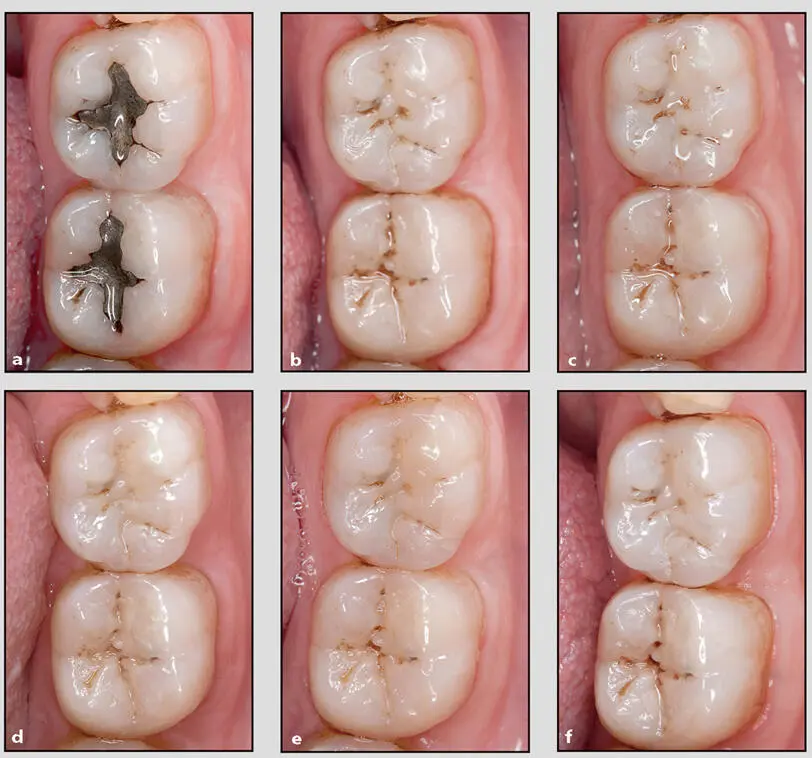
Fig 1-4 (a to f) A 5-year review of posterior resin composite restorations using a flowable resin composite system (G-aenial Universal Flo) with an incremental layering technique. Note the minimal wear.
Conclusion
Only time can provide the answers of knowledge, wisdom, and truth. Knowledge of the past and a desire to create are limited by the materials clinicians have available to them for restorative procedures. Advancements in resin composite technology continue to improve the practice of dentistry. Continuing technologic breakthroughs allow the clinician not only to comprehend the building blocks of the ideal composite restoration but also to implement and maximize the potential of new materials to attain more predictable and esthetic results. Although new ideas and concepts continually flood the marketplace, one should not discount the power a new biomaterial may have on planning, design, or procedure. These developments promise to simplify the clinical applications for esthetic and restorative techniques and ultimately improve the level of health care provided to the contemporary dental patient. Because only the passage of time can determine the success of a material, future clinical trials will be required to determine the long-term benefits of these new flowable resin formulations. The clinical applications provided in the following chapters demonstrate the potential of these flowable nanoparticle composite formulations to expand treatment options for a wider range of clinical situations.
References
1.Bayne SC, Thompson JY, Swift EJ Jr, Stamatiades P, Wilkerson M. A characterization of first-generation flowable composites. J Am Dent Assoc 1998; 129:567–577.
2.Labella R, Lambrechts P, Van Meerbeek B, Vanherle G. Polymerization shrinkage and elasticity of flowable composites and filled adhesives. Dent Mater 1999;15:128–137.
3.Tabassian M, Moon PC. Filler particle characterization in flowable and packable composites [abstract 3022]. J Dent Res 1999;79:213.
4.Baroudi K, Silikas N, Watts DC. Edge-strength of flowable resin-composites. J Dent 2008;36:63–68.
5.Ikeda I, Otsuki M, Sadr A, Nomura T, Kishikawa R, Tagami J. Effect of filler content of flowable composites on resin-cavity interface. Dent Mater J 2009;28:679–685.
6.Terry DA. Natural Aesthetics with Composite Resin. Mahwah, NJ: Montage Media, 2004.
7.Irie M, Tjandrawinata R, E Lihua, Yamashiro T, Kazuomi S. Flexural performance of flowable versus conventional light-cured composite resins in a long-term in vitro study. Dent Mater J 2008;27:300–309.
8.Summitt JB, Robbins JW, Schwartz RS. Fundamentals of Operative Dentistry: A Contemporary Approach. Chicago: Quintessence, 2001.
9.Terry DA. Direct application of a nanocomposite resin system, part 1: The evolution of contemporary composite materials. Pract Proced Aesthet Dent 2004;16:417–422.
10.Liebenberg WH. Assuring restorative integrity in extensive posterior resin composite restorations: Pushing the envelope. Quintessence Int 2000; 31:153–164.
11.Taylor DF, Bayne SC, Sturdevant JR, et al. Restoration width and complexity effects on posterior composite wear [abstract 35]. J Dent Res 1989;68:186.
12.Leinfelder KF. Composite resin in posterior teeth. Dent Clin North Am 1981;25:357–364.
13.Ferrari M, Kugel G. Handling characteristics of resin composites in posterior teeth. Compend Contin Educ Dent 1998;19:879–882.
14.Dietschi D, Spreafico R. Adhesive Metal-Free Restorations: Current Concepts for the Esthetic Treatment of Posterior Teeth. Berlin: Quintessence, 1999.
15.Sabiston CB. Etiology of cracked teeth: A review and proposal. Iowa Dent J 1994;80:13–14.
16.Roulet JF. Degradation of Dental Polymers. Basel: S. Karger AG, 1987.
17.Leinfelder KF. Composite Resins: Properties and Clinical Performance. In: O’Brien WJ, Powers JM (eds). Dental Materials: Properties and Selection. Chicago: Quintessence, 1989:139–157.
18.Paravina RD, Westland S, Kimura M. Powers JM, Imai FH. Color interaction of dental materials: Blending effect of layered composites. Dent Mater 2006;22:903–908.
19.Chartrand TL, Bargh JA. The chameleon effect: The perception-behavior link and social interaction. J Pers Soc Psychol 1999;76:893–910.
20.Paravina RD, Westland S, Imai FH, Kimura M, Powers JM. Evaluation of blending effect of composites related to restoration size. Dent Mater 2006;22:299–307.
21.Hall NR, Kafalias MC. Composite colour matching: The development and evaluation of a restorative colour matching system. Aust Prosthodont J 1991;5:47–52.
22.Jefferies SR. The art and science of abrasive finishing and polishing in restorative dentistry. Dent Clin North Am 1998;42:613–627.
23.Wilson F, Heath JR, Watts DC. Finishing composite restorative materials. J Oral Rehabil 1990; 17:79–87.
24.Kirk RE, Othmer DF, Kroschwitz J, Howe-Grant M. Encyclopedia of Chemical Technology, ed 4. New York: Wiley, 1991:397.
25.Myshko D. Nanotechnology: It’s a small world. Pharma Voice 2004;34–39.
26.Muselmann M. Composites make large difference in “small” medical, dental applications. Comp Tech 2003:24–27.
27.Estafan AM, Estafari D. Microleakage study of flowable composite resin systems. Compend Contin Educ Dent 2000;21:705–708.
28.Attar N, Tam LE, McComb D. Flow, strength, stiffness and radiopacity of flowable resin composites. J Can Dent Assoc 2003;69:516–521.
29.Gallo JR, Burgess JO, Ripps AH, et al. Clinical evaluation of 2 flowable composites. Quintessence Int 2006;37:225–231.
30. Dukić W, Dukić OL, Milardović S, Vindakijević Z. Clinical comparison of flowable composite to other fissure sealing materials: A 12 months study. Coll Antropol 2007;31:1019–1024.
Читать дальше
